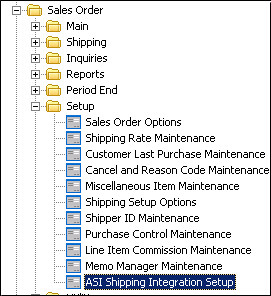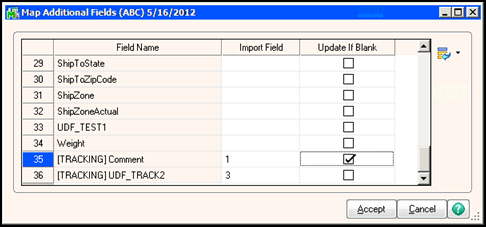
A new option has been added to the MAS90 Sales Order Setup menu. ASI Shipping Integration Setup will allow you to define where to find the files to import and how to handle the data in those files. You can also get to the ASI Shipping Integration Setup screen by clicking on the Setup button on the Import Shipping Information Import panel described later.

Import File Definition
Folder for Shipping Import – Enter the full path name to the folder where the shipping import file can be found. This is the file that is created by the shipping software package after every shipment. The shipping software will put the comma-delimited files here whenever a shipment is complete, or at the end of day. This shipping import function will search this folder for all the files to import.
Import File Extension – Enter the extension that will identify the files to import. The typical extension use for comma-delimited files is CSV (comma-separated values). However, you can put any extension that will properly identify the files to be imported. The shipping import function will look for files in the specified folder that have this extension.
Import File Delimiter – By default the shipping import function expects to have comma-delimited data to read, but you can tell it to look for tab-delimited or pipe (‘|’) delimited data instead.
Import File Has Header – Typically WorldShip will not put a header line in the file to be imported, but other shipping software might. If there is a header line in the file to be imported, check this box so that the import function will ignore the first line.
Field Mapping
In this section you tell the shipping import function where to find the fields it needs, and which fields to use. You must have an invoice, or sales order, or service order number in the import file, but the other fields are optional. However, the import file must include at least one of the fields Tracking ID, Weight, or Freight. If none of these fields are in the import file, then there is no reason to import.
Sales Order Number – Enter the field number in the import file that holds the sales order number. If the invoice field number is not zero, the import will try to use the invoice number first to match the shipping record. In our example file above, the sales order is in the second field, so we enter a ‘2’ here.
Service Order Number – If you are running ASI Service Center, the Service Order Number multi-line will be enabled. Enter the field number in the import file that holds the service order number. The import will use the service order number to match the shipping record only if the invoice and sales order field numbers are zeros.
Invoice Number – Enter the field number in the import file that holds the invoice number. You can use the invoice number, the sales order number or the service order number to match the shipping record, but if you provide all of them, the import will try to use the invoice number first. . In our example file above, the invoice is in the first field, so we enter a ‘1’ here.
Contract Number – This field only appears if Automated Rental Management is installed and unlocked on your system. Enter the field number in the import file that holds the contract number.
Note: If there is a value in the Contract Number field in the import file, the order and invoice will be ignored and the program will search first for a matching contract. If no matching contract is found, it will then search for an invoice or an order.
TrackingID – Enter the field number for the tracking ID. You can leave this blank if a tracking number is not being imported. In our example file above the tracking number was in the third field, so we enter a ‘3’ here.
Update Tracking Numbers from Shipping – Check this box if you want the tracking numbers from the shipping software to be written to the Sage 100 ERP tracking file.
Weight – Enter the field number in the import file where the weight of the package is found. In our example, the weight was in the third field, so we enter a ‘4’ here.
Update Invoice Weight from Shipping – Check this box if you want the weight from the shipping software to be updated to the header of the sales order invoice. The total weight of the shipment will display on the totals screen.
Freight – Enter the field number in the import file where the weight of the package is found. In our example file the weight was in the second field, so we enter a ‘5’ here.
Update Invoice Freight from Shipping – Check this box if you want to calculate and set the invoice freight amount based on the freight charges from the shipping software.
Ship Via – Enter the field number in the import file where the Ship Via can be found. The ship via code in the import file must match a valid ship via code in the Sage 100 ERP system or it will be ignored.
Update Invoice Ship Via from Shipping – Check this box if you want to put the ship via code from the shipping software into the ship via code on the invoice header.
Voided Flag – Enter the field number in the import file where the voided flag can be found. This is a Y or an N, depending on if this package shipment has been voided.
Map Additional Fields
This link will pop up the window shown below that allows you to map many additional fields on the invoice header or in the tracking record fields. These field mappings do not apply to Contracts if you are using Shipping Integration with Automated Rental Management.
NOTE – If the same field, such as FreightAmt, is in the main screen and the Additional Fields, the Additional Field mapping will happen after the main screen field mapping and will therefore override the main screen field mapping.

Field Name – The Field Name column gives a list of the available fields in the sales order invoice header table and in the tracking table into which you may map import information. Note that the tracking file fields have the [TRACKING] tag in front of them.
Import Field – Enter the column number of the field in the import file that you wish to place in the field name specified. If you leave it blank, nothing will be imported into that field.
Update If Blank – If you specify an Import Field to use in the file being imported from the shipping software, but that field is blank in the import file, check this box to write the blank value, anyway. If the Update If Blank box is cleared, then the target field will be left alone if nothing is in the column in the import record.
Options
Two columns of options allow you to modify what impact the shipping integration import has on the invoice or contract. If Automated Rental Management is not installed, you will not see the Contract column. The options have the same function, but you can turn them on and off separately for sales order invoices and rental contracts.
Update Tracking Numbers from Shipping – Check this box if you want the tracking numbers from the shipping software to be written to the Sage 100 ERP tracking file. This option will find tracking records that do not have tracking numbers, weight or freight on them and will insert the tracking number. If the tracking number already exists in the package tracking file, then the import will update the weight and freight (optionally) on that record.
Clear BLANK Tracking Before Importing - This option is enabled only if you choose to update tracking numbers. If you check this box, any blank tracking records that are not matched to an imported shipment record will be removed from the Sage 100 ERP package tracking table.
Update ShipWeight from Shipping – Check this box if you want the weight from the shipping software to be updated to the totals panel of the sales order invoice or the contract. The total weight of the shipment will display on the totals screen. This weight is used to calculate the shipping charges and may be recalculated based on line weights, depending on your option settings.
Update Weight from Shipping - Check this box to update the internal invoice or contract weight on the header. This numeric field is to show the true weight of the order based upon the shipment.
Update Freight from Shipping – Check this box if you want to calculate and set the invoice or contract freight amount based on the freight charges from the shipping software. If you choose to add per package or per shipment surcharges, they will be included in the resulting freight amount.
Default Per Package Surcharge - If you enter a dollar amount here, this amount will be added to every package freight unless the ShipVia record for the order specifies another amount. For contracts, you cannot override the per package surcharge from the ShipVia record. To override by ShipVia, take a loot at the user-defined field setup in the Ship Via Surcharges topic.
Default Per Shipment Surcharge - If you enter a dollar amount here, this amount will be added to the total shipment freight for this invoice or contract unless the ShipVia record for the order specifies another amount. For contracts, you cannot override the per shipment surcharge from the ShipVia record. To override by ShipVia, take a loot at the user-defined field setup in the Ship Via Surcharges topic.
Update Invoice Ship Via from Shipping – Check this box if you want to put the ship via code from the shipping software into the ship via code on the invoice header.
After Import
The last two fields on the screen determine what is done with the import file after the import is complete.
Delete Files After Import – Check this box if you wish to simply remove files after import.
After Import Move Files to Folder – If you do not check the Delete Files After Import box, you can specify a folder to which those files must be moved.
NOTE: The import function will read through all the files in the folder specified looking for those with the extension specified. Once it finds a file that matches, it will then read all the records in the file and try to match each record with a current shipment or invoice in Sage 100 ERP. If a record is not matched, it is copied to a file named "SO_531SOFShippingRecords" to be matched later.